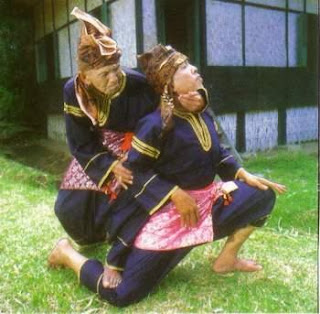 |
| Pencak silat |
Pencak silat refers to more than 800 individual schools of martial arts across the 13,000 islands of Indonesia. According to legend, they were used to fight against Dutch invaders. Later outlawed by the Dutch, this hybrid system is known as pencak in Java and Bali, and silat in Sumatra. The single term pencak silat was coined after Indonesia was unified, and then accepted in 1973. Some recent silat systems have adopted the Japanese martial art tradition of denoting rank with different-colored belts. The art has become popular around the world and has also developed a sporting tradition with its own world championships.
Pencak lineage
Knowledge of the art has been passed orally from teacher to student, so written records are few. Soldiers and warriors are known to have trained in silat forms in the Srivijaya kingdom in Sumatra between the 7th and 14th centuries and in the Majapahit kingdom on Java between the 13th and 16th centuries. Yet archeological evidence suggests silat may have been used as early as the 6th century. Many silat schools trace their lineage to the Buginese warriors, a band of tough mercenaries renowned for their combat skills. When the Dutch occupied the islands between the 17th and 20th centuries, the practice went underground and reemerged only after independence in 1949. Traditional Indonesian dances and rituals are thought to contain aspects of the ancient art.
Styles and weapons
Pencak silat has no standardized techniques, partly due to the fact that differences between schools depend on the environment in which students train. So, for example, the footwork techniques of urban styles differ from those of jungle variants. The Javanese people tend to use the art as a self-defense form. Even so, training regimes all include instruction in empty-hand techniques followed by weapons training.
Weapons include some common Indonesian fighting tools, such as sticks, staves, and rods made of bamboo, steel, or wood. The "cabang" is an unusual, three-pronged knife thought to derive from the trident. The "kerambit" is a small, curved blade that women often conceal in their hair. The "sabit" is a sickle used as a blocking, striking, and slashing weapon. The "keris" is a curving blade that is washed in acid. The "tedang" is a common sword with either a single-or double-sided blade.
Master and student
The large number of distinct pencak silat schools in Indonesia are the result of extremely localized styles that have arisen when a master in a village teaches his own method. This teaching may include aspects of shamanism, animism, healing, and other spiritual practices. Most silat players train in spiritual awareness methods, learning to harness what they believe are supernatural powers.
In general, would-be students offer gifts in order to be accepted by a traditional master. These may include a knife, which symbolizes sharpness of attitude and spirit, and a roll of white cloth, which the master keeps in a sacred place and uses to wrap the corpse of the student should he be killed.
The blood of a ritually slaughtered chicken may be spread on the ground where the student expects to train this signifies the blood the student would shed in fighting had he decided not to study the art. So, the relationship of master and student becomes akin to a blood relationship, such as that between father and son.
Diverse influences
The hand and foot strikes, locking techniques, and throws suggest the art has had Indian and Chinese influence. The throws typically launched from a very low stance or a deep crouch are often thought of as the silat signature move. Between the 7th and 12th centuries, Indonesia was influenced by Mahayana Buddhism and this, together with the arts, weapons, and philosophies that Indians and Chinese introduced, helped to shape the art. Experts believe that Hindu culture and its grappling techniques influenced silat groundwork and, with the later arrival of Islam, came the distinct "jambia" the short, curved Arab dagger that probably inspired the pencak silat keris blade.



No comments:
Post a Comment